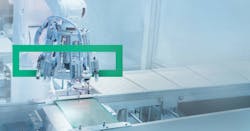AI-Enabled Solution a Gamebreaker for Maintenance and More
“Most of our enterprise customers are struggling to even get started with AI,” reveals Beena Ammanath. As the global vice president of Artificial Intelligence for HPE’s Pointnext, her role is to help transform businesses via digital solutions, but she says it hasn’t been easy for most manufacturers.
Apart from the plethora of anecdotal evidence she can rattle off, studies such as Gartner’s 2018 CIO Agenda Survey indicate it’s an uphill battle. A scant 4% of the 3,160 CIOs surveyed (across 98 countries) have implemented AI. Less than half plan to do so soon.
“Who cares?” you may ask. Factory production is booming without it. You have other more pressing needs. And who wants to live in a world run by Skynet?
The problem is that in real life, AI doesn’t mean a sentient supercomputer; it refers to the computing programs and algorithms that can fetch and analyze data among a million other things to help give your operation an edge. The other problem is that on this ultra-competitive global playing field, you need every advantage you can get.
And using AI where appropriate is a potentially game-breaking advantage. It’s not the beast mode running back that plows over defenders, but rather a trusty assistant coach who can break down your plant’s data like it’s game film, recommending where to pivot and when to speed up or slow down.
It’s what the manufacturing heavy hitters’ C-Suite uses to make informed important decisions, and at the plant management level, keeps things running smoothly so you can focus on making things of the highest quality for the optimal cost. Instead of putting out fires daily, you can figure out how to burn the competition.
“Global tech giants are investing heavily in AI, but the majority of enterprises are struggling both with finding viable AI use cases and with building technology environments that support their AI workloads,” Ammanath says. “As a result, the gap between leaders and laggards is widening,”
To counter this, HPE has recently launched a few new offerings to help factories go from struggling to thriving. Companies can start with the Artificial Intelligence Transformation Workshop, which identifies and prioritizes use cases that will convert AI into the insights that will cut defects, boost production, and provide real competitive advantage. A more specific product, the Digital Prescriptive Maintenance Services, targets equipment downtime by predicting, suggesting, and automating fixes before anything breaks.
While predictive maintenance uses sensors and data to alert you to an overheating machine, the prescriptive model does that and more. Ammanath says the Pointnext solution could then automatically switch on a cooler to reduce the heat—or shut the whole thing down. You train the model to do what is best for the operation; the A.I. doesn’t go rogue.
While it does all the computing, you look like the genius. Kaeser Compressors discovered this when the it ran a pilot project with HPE’s Pointnext solution along with SAP HANA, an in-memory data platform. Embedded in air compressor equipment it would sell to customers, the solution constantly fed data, such as temperature, vibration, and humidity, to the predictive analytics system. In real time, Kaeser would know if a part is likely to fail and replace them during scheduled maintenance.
This led to a 60% reduction in unscheduled system downtime, as well as not having to make an expensive emergency visit. The benefits for the customer are obvious: pneumatic applications or whatever else they use the compressors for can go on as usual.
Along with building client trust, Kaeser can now more efficiently manage inventory, which created an estimated annual savings of $10 million in break-fix costs. The insight also allows Kaeser to improve product design and prevent future device failures.
Finally, it lets companies like Kaeser to sell their services as a solution.
“We’ve also used this new IIoT infrastructure to launch an air-as-a-service business model, helping us move costs from CAPEX to OPEX,” says Kaeser CIO Falko Lameter.
By monitoring usage and analyzing trends the Kaeser’s Sigma Air Manager, CEMEX, a building supplies manufacturer, was also able to reduce compressed air energy usage by 28.5%.
This is the true power of AI that unleashes exponential growth by “rethinking new revenue channels and products,” unlike customer service chat bots that may yield some incremental improvements, Ammanath says.
“That’s where I think the value of AI truly is,” she says.
It’s a promising technology, one that companies big and small will be using soon.
“The complete industry will go this way in the next decade,” Ammanath predicts.
But it’s still so new that getting plants to buy in could be the tougher than programming the AI.
“It’s never about the algorithm,” she says. “It’s about adoption. Plant workers have been doing their job for 20 to 25 years. They know when a machine is going to fail just by instinct. How do you get them to actually trust a piece of software? When [AI] tells them this machine is going to go down in a week, they don’t believe it.”
As they see more and more competitors leveraging data in new, innovative ways, we have a hunch they will start believing, too.
About the Author
John Hitch
Editor, Fleet Maintenance
John Hitch, based out of Cleveland, Ohio, is the editor of Fleet Maintenance, a B2B magazine that addresses the service needs for all commercial vehicle makes and models (Classes 1-8), ranging from shop management strategies to the latest tools to enhance uptime.
He previously wrote about equipment and fleet operations and management for FleetOwner, and prior to that, manufacturing and advanced technology for IndustryWeek and New Equipment Digest. He is an award-winning journalist and former sonar technician aboard a nuclear-powered submarine where he served honorably aboard the fast-attack submarine USS Oklahoma City (SSN-723).

